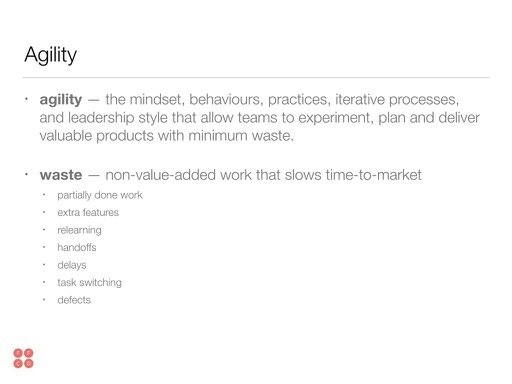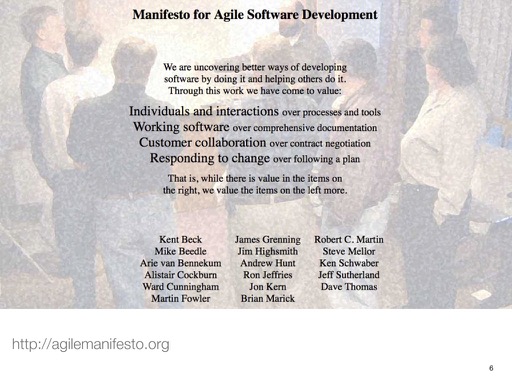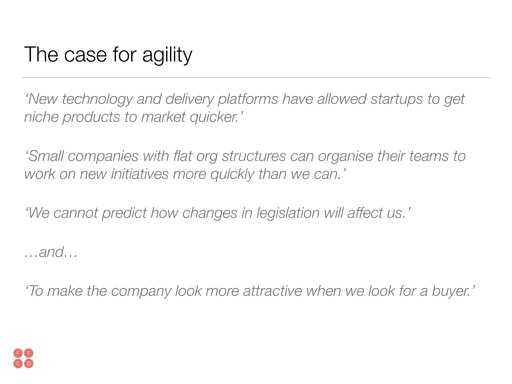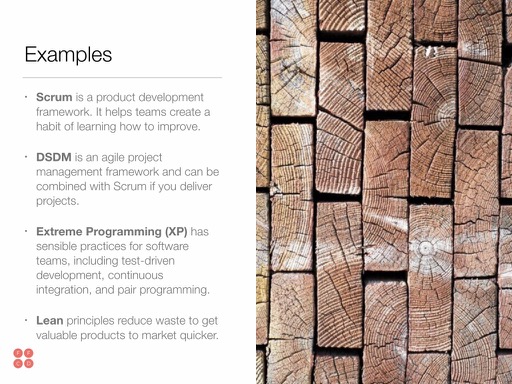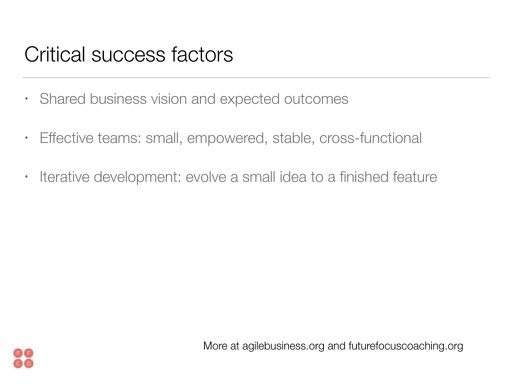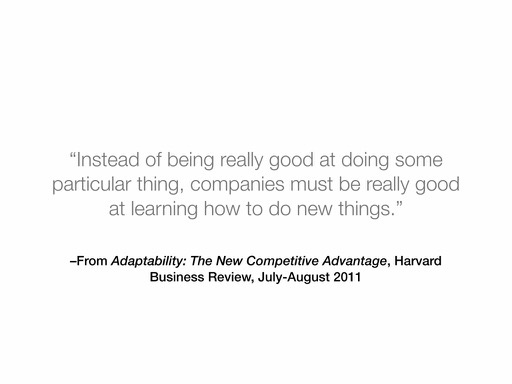
Transcript of Is Agile Right for Us?, from the Free Webinar Series to Create an Agile Organisation, on 20th August 2019. Presented by Laura Re Turner, Director, Future Focus Coaching.

Welcome
Thanks for joining us today. I think it’s a good idea to start with a definition and when I think of agility, it’s a whole collection of things for me. It’s the mind-set, behaviours, practices, iterative processes and leadership style, which is very important that allow teams to experiment, plan and deliver valuable products with minimum waste. And the reference to waste is a very over referenced to lean which is where most agile methods originate and it’s important to think about sources of waste so that we know what’s slowing us down in organisations. It’s all the non-value-added work that often leads to frustration; partially done work that doesn’t lead to value because we can’t deliver something that’s partially done. It started, sits on the shelf and maybe never gets finished; extra features, re-learning or extra processes, handoffs, delays, task switching and defects.
If we think about the hierarchical and sometimes distributed organisations working in silos kind of old-school organisations we’re thinking of them now, a lot of them have symptoms of a lot of these wastes. I think it’s important to provide a definition because the way the word agile is being used lately is as a thing or a process or a methodology. I’m hearing the word methodology more and more these days, which is interesting. I’m always reminded of Dave Thomas’s terrific blog where he says “Agile is not a noun” it never was. If you look it up in the dictionary it’s not a noun. To us when we think about how to be effective and get the most value from being agile and agility, it’s important to think of whole collection of behaviours, mind-set, leadership style and processes and tools that help us be flexible.
Manifesto for Agile Software Development
You’re probably aware of the manifesto for agile software development and this is perhaps where the word kind of caught fire agile. And I remind people that being agile is really about the left hand statements and yet when we use agile as a noun it makes us think of a single process or a software development life cycle or the one methodology that we need to adopt to be successful. So I don’t want to say too much about the manifesto because I know so many people have seen it but I think it’s important to remember that agility is a way of working and not a single process.
Should everyone use an agile approach now?
So we get questions all the time in our training courses; should everyone use an agile approach now? Should everyone be agile? Should everyone have scrum teams and scrum masters and throw away documentation? I’m just wondering what questions you have about that? I haven’t seen any questions come into the Q&A yet, but perhaps you have some burning questions about whether or not one of the iterative processes or methods or frameworks that we’ve heard of before is the best one. Is that the way to go? Is there a reason the whole world seems to want to be agile now?
The case for agility
Well things that we’ve heard from our clients are for example; new technology and new delivery platforms have allowed start-ups to get new products, niche products to market quicker and they’re actually taking away market share for some of the products that we have that we’ve enjoyed a good sales on for quite a long time. Also, we’ve heard things like small companies with flat organisation structures can organise their teams to be more nimble, to come up with ideas and to be able to organise themselves quite quickly to work on new initiatives much more quickly than we can.
We’ve also wrote things like we have a really hard time predicting how changes in legislation will affect us, especially from the government agencies that we work with. To make the company look more attractive when we look for a buyer; getting ready to sell the company and we want to make the company look a little bit more attractive – interesting.
Poll: What are your Reasons for Becoming ‘Agile’?
So, I’m wondering what are some of your reasons for becoming agile? It wouldn’t be an interactive webinar without a little poll and I thought it would be interesting to find out from you what are some of your reasons given in your organisation for becoming agile? So I’d like to invite you just to choose as many of the statements that you think apply to you and choose as many as you want and go ahead and vote and we’ll take a minute to give you a chance to read through the options and let’s find out what you think.
It looks like everyone’s voted; I’d like to show you the results. So 33% said to reduce costs and actually we’re hearing more and more that people are looking to use an agile approach to reduce costs. 50% said it’s to stay competitive while delivering innovative products and then 83%, the majority said that the reason for becoming agile in our organisations is to reduce the time that it takes to get new products and services to market. So it’s about time and speed. I thought it would be interesting to throw in a few slightly humorous reasons because the competition is doing it and sometimes there is a real reason although perhaps not stated explicitly or out loud.
The wider community: Reasons for Becoming Agile
So I thought it would be interesting also to see what were some of the reasons that other people more widely in the community said that they were becoming agile, what were some of the reasons? If you’re anything like me you tend to follow the reports and anything that’s reported on where the market’s going and where organisations are moving to and the reasons for adopting an agile approach.
Well, I thought it would be interesting just to take a snapshot from Version One’s annual State of Agile report; this came out in May and they surveyed thousands of people working in the domain every single year. Perhaps not surprisingly, most people said in response to the survey that their top reason was to accelerate software delivery very much like the reasons that we stated in the pole.
Enhancing ability to manage changing priorities which really speaks to the amount of change in the external business environment and the uncertainty that we’re experiencing now. To increase productivity is interesting. I think there’s a perception that using an agile approach will somehow make us faster; perhaps it’s the daily stand-ups that people love and to improve business of IT alignments – that’s a massive one. I would love to see more people stating that as a reason for becoming agile because it’s one of the biggest things that we can do actually to increase our ability to change is having a real business focus right the way through all the functions including the IT function. I’ll leave you to find this on the web Version One.
To find out what it really means to become agile, see my new book Becoming Agile: Coaching Behavioural Change for Business Results, published by Open University Press in 2021.
Which processes should we keep?
So when I published the topic for the webinar, I thought it might be interesting to think about the processes a little bit. Even though we say in the Agile Manifesto that we value individuals and interactions over processes and tools people are always interested in what should I keep? How much of project management methods should we keep and how do we decide? Well, I wanted to give you a few examples of the best-known agile approaches and methods that I think are in use today and being combined.
Scrum- Scrum remains extremely popular if you have a look at the Version One report. Scrum is a product development framework and helps teams to create a habit of learning how to improve. I often get questions like ”are we doing it right?” “What are we leaving out and what’s the impact of not having a sprint review or doing the daily stand-up?” To me, Scrum is a way of creating good habits to reflect and improve their processes, and improve the requirements for the products that they’re building.
DSDM- Another popular one is called DSDM, also known as Agile Project Management. It’s a project management framework and parts of it look an awful lot like Scrum. It can be in fact combined with Scrum if you are delivering projects. So I think one of the traditional mindsets is that when we move to Agile, we’re actually replacing everything that we’ve done before with a new methodology or a new process and in fact many people don’t think about combining the popular approaches. In fact, when we’re delivering projects, we need some kind of project governance so there’s no reason why we can’t combine Scrum and DSDM.
Extreme Programming- Likewise for software projects, most people are aware of test-driven development and continuous integration, but few people realise that that whole suite of practices comes from Kent Beck and all the guys that created extreme programming back in the early 1990s. And for software projects we absolutely need test-driven development and continuous testing and checking to be sure that we’re fixing the bugs that we create so soon as possible.
Lean- So that together with the lean mind-set of reducing waste together to me that’s a whole suite of practices and processes that we should be using in combination.
Critical success factors
It’s important to think about critical success factors.
- Having a shared business vision and understanding business outcomes both among the business stakeholders and the guys who deliver the products and projects it’s really, really important, everybody has to understand why we’re delivering the project.
- Effective teams and what we mean by effective teams is really a whole list of things. We know that small teams is really, really important for communication and even better when we can see each other because it just reduces miscommunication.
- Stable and cross-functional. There’s nothing worse for killing productivity than asking people to work on two or three things at once. To me is kind of like trying to get your chores done on a Saturday, you know, the cat comes in and wants to be fed and the husband is in the garage playing with paint cans and needs a hand with getting a rag or an emergency clean up. The postman knocks on the door and has your Amazon parcel and at the same time you’re trying to get the hoovering and the dusting done. When you’re working on three or four things at once, it seems like everything is in progress and nothing’s getting done. So protecting the team to be able to focus on one product or one project at a time is important and really allowing them to make changes to the process and their practices in the way they get the work done so that their practices are fit for purpose.
- Iterative development – evolving a small idea to a finished feature is really, really important and taking on very small pieces of work just like in lean where we prefer to work on small batches of work so that we can get something started and finished as quickly as possible.
I have another quote for you. This comes from the Harvard Business review article.
For me the really key word in that whole sentence is learning. The agile methods for me really come down to the ability to learn and get transparency and find out more about the processes and tools that are really working for us and the practices that are going to lead to success and what the customer really wants and the features that are really resonating with them. The requirements that we might have put on a backlog or requirements list that are no longer needed because either the markets moved on or something else come in and becomes more important to us.
Ready to get started? Contact us. We’ll respond within one business day.

